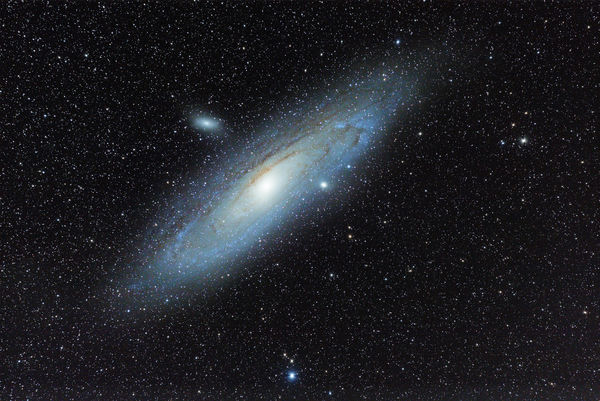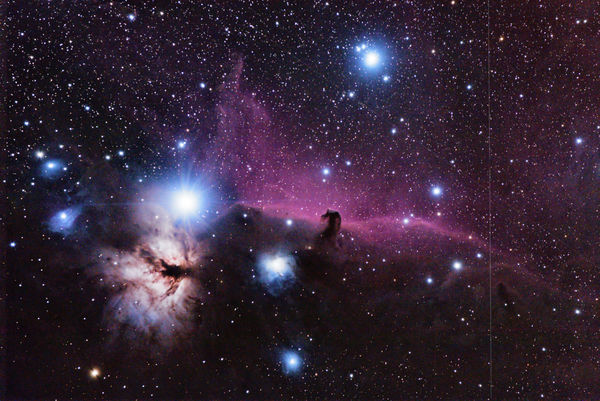Horsehead Nebula
Nov 6, 2019 16:36:11 #
Ballard wrote:
For these shots I had the camera and lens piggybac... (show quote)
Thank you very much for the details. Have you found that the DSLR plus the 500mm f4 + the 2X TC produces better images of galaxies and nebulae than a conventional CCD imager on your APO refractor?
Nov 6, 2019 19:16:17 #
Very impressive for an image taken using a DSLR camera. You must have put more effort into producing this image than any I have ever produced. Thank you for sharing it with us.
Nov 6, 2019 21:55:09 #
Nov 7, 2019 12:14:21 #
Ballard
Loc: Grass Valley, California
rmm0605 wrote:
A great photo of horsehead. What telescopic equipment are you using and where did you take the photo?
I had my DLSR (EOS 5D Mark IV) connected to a Canon 500mm F4 lens with a 2X teleconverter giving it a 1000mm focal length. The camera and lens were piggy backed on my APO refractor that was mounted on an old Losemandy G11 mount that I have upgraded with DC servos and the Losemandy Gemini 2 telescope controller. I used a Starlight Express Lodestar X2 CCD inserted in the APO for guiding. My laptop controlled the guiding using the Freeware PHD guiding program via a USB connection to the CCD and an Ethernet connection to the mount. The laptop also controlled the DSLR with the Canon EOS software. To keep warm I remote mounted the Lap Top with my DeskTop computer and controlled the photo session from my office. The telescope was located in my back patio in Grass Valley California.
Nov 7, 2019 12:48:13 #
Ballard
Loc: Grass Valley, California
TriX wrote:
Thank you very much for the details. Have you found that the DSLR plus the 500mm f4 + the 2X TC produces better images of galaxies and nebulae than a conventional CCD imager on your APO refractor?
When used at 500mm and 1000mm with the 2X extender the Canon lens is excellent (no coma at all even at the very edge of the field. This lens cost ~2X what my APO cost even though I bought the Canon lens used). I don't currently have a conventional CCD other than a Starlight Express Lodestar X2 with is used only for guiding as it has too small a field of view. I expect that a high quality CCD with a peltier cooler would be far better than a DSLR but I go with what I've currently got. On another note I recently switched to using pixinsight (started the free trial a couple of weeks ago) for my astro photos and it makes a huge difference. Below is a shot of Andromeda (M31) that I reprocessed with pixinsight and the link included at the end of this message is the original photo I posted of Andromeda using Deep Sky stacker and the EOS picture
https://www.uglyhedgehog.com/t-600370-1.html
Nov 7, 2019 13:22:41 #
Ballard wrote:
When used at 500mm and 1000mm with the 2X extender... (show quote)
Wow - these are just excellent! I hate to keep asking questions, but would be interested in the model of your refractor.
Cheers,
Chris
Nov 7, 2019 14:57:06 #
Ballard
Loc: Grass Valley, California
df61743 wrote:
Terrific shot!
It might have been pretty cool to have just left the satellite trail in there. Maybe you could post a copy of the original?
Dick
It might have been pretty cool to have just left the satellite trail in there. Maybe you could post a copy of the original?
Dick
Hi Dick
Here is a version with the satellites in the image. Note: The brightest satellite must have been slow moving as it was seen on one frame and there is a gap until the next frame started. I changed the stacking parameters to prevent some of the filtering to allow all the satellites to be shown and didn't clone out the dim ones.
Nov 7, 2019 15:10:38 #
Nov 7, 2019 15:10:50 #
Ballard
Loc: Grass Valley, California
TriX wrote:
Wow - these are just excellent! I hate to keep asking questions, but would be interested in the model of your refractor.
Cheers,
Chris
Cheers,
Chris
Hi Chris
The refractor I have is the " Explore Scientific FCD100 Series 127mm f/7.5 Carbon Fiber Triplet ED APO Refractor Telescope" and it works well and I have used it for some good shots of lunar and solar eclipses. However it was only used as a guide scope for the horsehead nebula and the images where taken using a Canon 500mm F4.0 EF L IS-USM lens with a Canon EF 2X type III Extender. The diameter of the lens on the Canon and the ED APO are within a millimeter or two the same diameter but the Canon lens is very highly corrected even better than the refractor (But even used it cost a lot more also).
All questions are welcome.
Thanks Ballard
Nov 7, 2019 15:28:39 #
Ballard wrote:
Hi Chris br The refractor I have is the " Exp... (show quote)
Thank you very much!
Chris
Nov 7, 2019 18:52:18 #
WOW! Absolutely amazing, not only did you catch the horse head, you caught the body as well. Outstanding in all respects. Thank you
Nov 7, 2019 20:30:20 #
df61743
Loc: Corpus Christi, TX
Ballard wrote:
Hi Dick
Here is a version with the satellites in the image.
Here is a version with the satellites in the image.
Thanks for posting that. I believe it makes an excellent observation that this is truly the space age. An era of exploration and discovery.
On 4 October 1957 the Soviet Union launched the world's first artificial satellite, Sputnik 1. Since then, about 8,900 satellites from more than 40 countries have been launched. According to a 2018 estimate, some 5,000 remain in orbit. Of those about 1,900 were operational, while the rest have lived out their useful lives and become space debris. Approximately 63% of operational satellites are in low-Earth orbit, 6% are in medium-Earth orbit (at 20,000 km), 29% are in geostationary orbit (at 36,000 km) and the remaining 2% are in elliptic orbit. A few large space stations have been launched in parts and assembled in orbit. Over a dozen space probes have been placed into orbit around other bodies and become artificial satellites of the Moon, Mercury, Venus, Mars, Jupiter, Saturn, a few asteroids, a comet and the Sun.
It's probably difficult to produce a photo like yours without satellite trails.
Dick
Nov 7, 2019 22:07:13 #
I think it looks pretty neato-keeno myself. Great job. Thanks for letting me gaze on your sky today.
Nov 7, 2019 22:49:56 #
leicajah
Loc: Texas, grew up in Louisiana
I’ll always remember my Dad taking me outside to see the USSR’s satellite and our satellite fly in opposite directions. It influenced me to have a career in ICBMs. Her name was close to being Leica
Nov 8, 2019 05:57:49 #
If you want to reply, then register here. Registration is free and your account is created instantly, so you can post right away.






